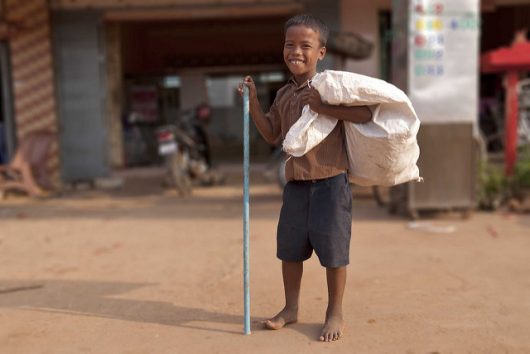Top 10 Facts About Poverty in Cambodia

Cambodia has made phenomenal progress against poverty in the past few decades. The country surpassed the Millennium Development Goals and expanded their road system, irrigation and agriculture market. The following are the top 10 facts about poverty in Cambodia.
Top 10 Facts About Poverty in Cambodia
- Around 32 percent of children under 5 in Cambodia are stunted. Despite economic growth, Cambodia still struggles with healthcare and education. Decreasing nutritional deficiency in children is essential to mitigating child stunting.
- 12.3 million people, or around 70 percent of the population in Cambodia, do not have access to a piped water supply. Access to clean drinking water is crucial to alleviate disease in impoverished communities. Limiting the spread of disease is an important aspect of decreasing poverty in Cambodia.
- As of 2015, the life expectancy rate in Cambodia was reported at 68.4 years. This rate is significantly influenced by poverty. Lack of sanitation, education and healthcare are all symptoms of poverty that contribute to limited life expectancy.
- Approximately 90 percent of Cambodia’s impoverished population lives in rural areas. Much of them depend upon agriculture for their means of survival. This is good while crop prices are doing well, but these communities are also vulnerable to changes in weather and fluctuating crop yields.
- Two-thirds of the households in Cambodia experience seasonal food shortages every year. This is one example of a consequence of living in a rural area that depends on living off the land. Food supply can change with the seasons, leaving it as an unreliable source of sustenance.
- A history of political instability contributes to poverty in Cambodia. In the 1970’s, a Marxist leader named Pol Pot began the Khmer Rouge regime that ultimately led to the death of 2 million people in Cambodia. Pol Pot wanted Cambodia to be an agrarian country that did not depend on anything modern. As a result, Cambodia was surpassed by other countries in medical and technological advancements.
- There is limited access to quality healthcare, especially in rural areas. Cambodia is a mountainous region, and people living in rural communities are often isolated and have to travel a long way to get to a clinic. While the geography cannot be changed, expanding and opening more clinics would help to reach more people. Also, eliminating fees for services and supplies would help those who are not fortunate enough to afford them on their own, especially considering that healthcare in Cambodia is supposed to be free.
- The poverty rate has decreased from 47.8 percent in 2007 to 13.5 percent in 2014. This massive decrease was largely driven by growth in Cambodia’s rice market. Rising prices for rice and a better transportation system for the product has created a more prosperous economy for rural dwellers.
- Habitat for Humanity is working to rebuild slums in urban Cambodia. HFH is focusing on building durable homes with access to water and sanitation to replace the fragile shacks in which many impoverished Cambodians are living. They are also training families in HIV/AIDS prevention and financial literacy.
- The maternal mortality rate has decreased considerably in recent decades. In 2005, the ratio per 1,000 births was 472. In 2014, it had decreased to 170. Additionally, the under-five mortality rate declined from 83 per 1,000 in 2005 to 35 in 2014.
Cambodia has made great strides since the start of the century in working to alleviate poverty and recover from the Khmer Rouge regime. Some of these top 10 facts about poverty in Cambodia still paint a more negative picture, but others provide hope for the future. If the good fortune that has befallen the agriculture industry continues and more awareness can be raised on the conditions that need improvement in Cambodia, one can expect to continue to see growth in the coming years.
– Amelia Merchant
Photo: Flickr
